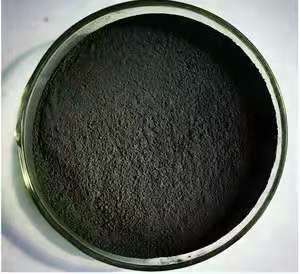Titanium carbide powder is a crystalline solid with a gray metallic luster, hard quality, hardness second only to diamond, and weak magnetism. The molecular weight is 59.89, the melting point is 3140 °C, the boiling point is 4820 °C, and the relative density is 4.93. Hardness 9-10. Insoluble in water, soluble in nitric acid, and aqua regia. It is stable to the air below 800℃, corrodes in the air above 2000℃, and can react with pure oxygen. 1150°C. Used in the manufacture of cemented carbide, also used as electrodes and abrasives for arc lamps. Today we will specifically introduce the synthesis method of titanium carbide.

Carbothermic reduction method
Use carbon black to reduce TiO2, the reaction temperature range is 1700-2100℃, and the chemical reaction formula is: TiO2(s)+3C(s)=TiC(S)+2CO(g).
Direct carbonization
Ti powder and carbon powder react to generate TiC. The chemical reaction formula is: Ti(s)+C(s)=TiC. Because it is difficult to prepare sub-micron metal Ti powder, the application of this method is limited. The above reaction takes 5-20 hours to complete, and the reaction process is difficult to control. The reactants agglomerate seriously, and further grinding processing is required to prepare fine particles. Granular TiC powder. In order to obtain a purer product, it is necessary to chemically purify the fine powder after ball milling.
Chemical vapor deposition
The synthesis method utilizes the reaction between TiCl4, H2, and C. The reactant reacts with the hot tungsten or carbon monofilament, and TiC crystals grow directly on the monofilament. The TiC powder synthesized by this method has strict limits on its output and sometimes even it's quality. In addition, due to TiCl4 and the product, The HCl contained in it is strongly corrosive, so be careful when synthesizing it.
Sol-gel method
A method for preparing small particle size products by thoroughly mixing and dispersing materials by means of a solution. It has the advantages of good chemical uniformity, small powder particle size and narrow distribution, and low heat treatment temperature, but the synthesis process is complex and the drying shrinkage is large.
Microwave method
Take nano TiO2 and carbon black as raw materials, use the principle of the carbothermal reduction reaction, and use microwave energy to heat the material. In fact, it uses the dielectric loss of the material in the high-frequency electric field to convert microwave energy into heat energy, so that nano-TiO2 and carbon are synthesized into TiC.
Blast impact method
The titanium dioxide powder and the carbon powder are mixed in a certain proportion and pressed into a cylinder of Φ10mm×5mm to prepare the precursor, the density is 1.5g/cm3, and the laboratory is put into a metal constrained outer cylinder. Put it into a self-made airtight explosion container for the experiment, and collect the detonation ash after the explosion shock wave. After preliminary sieving, large impurities such as iron filings are removed, and black powder is obtained. The black powder becomes brown after being soaked in aqua regia for 24 hours, and finally put into a muffle furnace and calcined at 400°C for 400 minutes to obtain a silver gray powder.
High-frequency induction carbothermic reduction method
Weigh and mix the pigment-grade titanium dioxide powder and charcoal powder at a molar ratio of 1:3 and 1:4, add them into a ball mill tank, and mill on a planetary ball mill for 6-10 hours at a speed of 300-400r/min, and then grind the material. Press the tablet press to form a block of 2cm×2cm~2cm×4cm, and finally, put the material into the graphite crucible and put it into the high-frequency induction heating equipment, argon gas as a protective atmosphere, and gradually adjust the current of the high-frequency induction equipment to 500A causes the material to undergo a carbothermal reduction reaction, and keep it for 20 minutes. After the heat preservation is completed, the reduced product is naturally cooled to room temperature under an argon atmosphere, and the reduced product is taken out, and after grinding and crushing, ultra-fine titanium carbide powder is obtained.
Metal thermal reduction
A solid-liquid reaction method is an exothermic reaction, so the reaction temperature is low, the energy consumption is small, but the raw materials are relatively expensive, and the CaO and MgO in the product are pickled and cannot be recycled.
High-temperature self-propagating synthesis
(SHS) The SHS method is derived from an exothermic reaction. When heated to an appropriate temperature, the fine-grained Ti powder has high reactivity. Therefore, once the combustion wave generated after ignition passes through the reactants Ti and C, Ti and C will have enough reaction heat to generate TiC. The SHS method has a very fast reaction, usually less than one second. The synthesis method requires high-purity, fine Ti powder as raw material, and the output is limited.
Reaction ball milling technique
Reactive ball milling technology is a technology that uses the chemical reaction between metal or alloy powder and other elements or compounds in the ball milling process to prepare the required materials. The main equipment for preparing nanomaterials with reactive ball milling technology is a high-energy ball mill, which is mainly used to produce nanocrystalline materials. The reaction ball milling mechanism can be divided into two categories: one is mechanically induced self-propagating high-temperature synthesis (SHS) reaction, and the other is reaction ball milling without obvious exotherm, and the reaction process is slow.
Ozbo.com (aka. Tanki New Materials Co.Ltd.) is a trusted global chemical material supplier & manufacturer with over 12 years of experience in providing super high-quality chemicals and Nanomaterials. As a leading nanotechnology development and product name manufacturer, Tanki New Materials Co.Ltd dominates the market. Our professional work team provides perfect solutions to help improve the efficiency of various industries, create value, and easily cope with various challenges. If you are looking for titanium carbide,please feel free to contact us.


